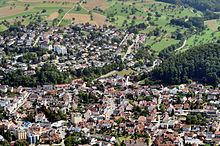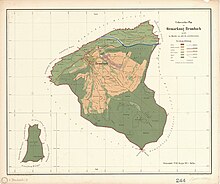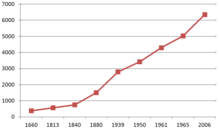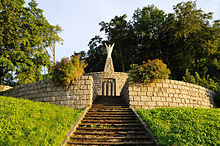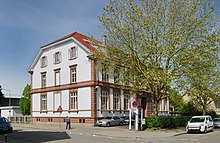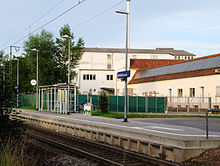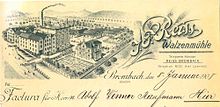Brombach (Loerrach)
|
Brombach
City of Loerrach
|
|
|---|---|
| Coordinates: 47 ° 38 ′ 3 ″ N , 7 ° 41 ′ 33 ″ E | |
| Height : | 311 (310-487) m |
| Area : | 9.87 km² |
| Residents : | 6354 (Dec. 31, 2006) |
| Population density : | 644 inhabitants / km² |
| Incorporation : | 1st January 1975 |
| Postal code : | 79541 |
| Area code : | 07621 |
|
Brombach district
|
|
Brombach (Alemannic also Bromech ) is the largest district of the city of Lörrach with 987 hectares of municipal area . After Stetten with 6354 inhabitants (2006) it is the second largest in terms of population. Brombach is located in the northeastern part of the urban area between the left side of the Wiese river and the western foothills of the Dinkelberg . It forms a sub-center of Lörrach with shops and facilities for short and medium-term needs. Brombach was first mentioned in a document in 786. In the 13th century, the village fell into the hands of the Reichenstein family through a castle foundation , which remained in their possession for over 500 years. The village of Brombach has been part of the city of Lörrach since 1975.
Location and geography
The core of Brombach extends over a flood-free lower terrace and the alluvial cone of the Löhrgraben between the river Wiese and the Dinkelberg. In addition to relatively young residential areas, industrial areas have settled in the floodplains . In the 1970s, the Bühl residential area developed on the heights of the Dinkelberg . From the floodplain to the low terrace and up to the heights, the municipality area is divided into three parts with a height difference of over 150 m between the lowest and the highest point on the municipal area. An irregular course along the old town center on the ring road is to be established as the outline of the street code. Several parallel streets have been aligned on the Lörracher Strasse / Schopfheimerstrasse thoroughfare, which runs from northeast to southwest.
The village of Brombach also includes Rotte Juch, about 1.6 kilometers southeast . The Rotte consists of four courtyards and is accessed from Brombach via Hüsingerstraße. The pass road from Brombach to Hüsingen runs through the village on a plateau at around 388 m and belongs to Brombach. A few dirt roads branch off from Juch, as well as one country road that serves as the entrance to the Bühler Hut.
The Homburg Forest is located between the city center of Lörrach and Brombach . The highest elevation of Brombach is the Mezelhöhe in the Gewann Bollhalden in the south of Brombach with a height of 487 m above sea level. NN . The Stockert district in the Hauinger Wald is a 38-hectare exclave belonging to Brombach and located north of the actual district.
history
Early settlement and first mention
The current district of Brombach was already settled by the Celts , Romans and Alemanni . In November 1894 skeletons with several grave goods were found two kilometers east of Brombach on the border of the Hüsingen forest. The group of graves at the so-called "Blinzgraben" date from the Carolingian era after 700. The village of Brombach was mentioned for the first time on February 27, 786 in a document attesting a donation from Ercanpert to an abbot named Werdo from the St. Gallen monastery . It is known that Ercanpert was a Frankish civil servant in Brombach. With the donation he transferred part of the rights and income that previously belonged to the "Holy German zu Brombach" to the monastery. It is not known whether Ercanpert was the founder or heir of the church and possessions in Brombach. As a further part of the deed of donation, Ercanpert obliged his brother Hanno to give ten denarii annually to the monastery. In addition to the possessions in Brombach, the church in Weil was also part of the disposition. In the first lines of the St. Gallen certificate it says:
“Sacrosancte ecclesia, qui est constructa in paco Turgauginsi in onore sancti Galii, hubi Werdo abba ad presens esse vedetur. Ego Ercanpertu (s) sumsit mihi consilius adque voluntas bona, ut aliquid tale parcione de exlesia, quod habui in Prampahch in onere santi Germani, et in Willa talte parcione de eclesia, quod ibi habui, ad ipso sancto vel ad ipsam casam Dei trado adque transfundo, ut ab hac diem abiant; [...] "
In German:
“The most holy church, which was built in Thurgau in honor of St. Gall, where Werdo is currently abbot. I, Ercanpert, have made the decision and good will, my share that I have in the church in Prampahch (Brombach) in honor of St. Germanus and those I have in the church of Willa (Weil), the saint and the house of God to give yourself. I also did that. [...] "
Meaning of the place name
From 786 to 1493 the spellings are Prampahch (786), Branbach (five times between 1258 and 1351), Brambach (14 times between 1259 and 1514), Bronbach (1419) and Brombach (in a document copy from 1113 from the 16th century and often since 1493). The linguistic change from long [a] to long [o] is due to the Alemannic dialect . The Middle High German word "brame" ( Old High German : "bramo") means thorn bush and is contained in the word blackberry (Middle High German: "bramber"). Although the city's coat of arms shows a fountain and thus refers to the corresponding meaning, old documents rather indicate that the name is derived from the word "blackberry". This results in the meaning of the place name Brombach: the settlement on a stream, on the banks of which many thorn bushes grow.
The era of the Reichenstein family
In 1113 Walcho von Waldeck handed over his possessions in Brombach to the St. Blasien monastery . In the 13th century, the founding of a castle by the Lords of Reichenstein is known . For over 500 years, Brombach belonged to this noble family who had their manor house in the center of Brombach. In 1294 Mathias Reich sold the moated castle and the village to his brother, the Basel Prince-Bishop Peter I. The document states:
“Everyone involved should know that I would give Mathias Reich, treasurer at the court of the Bishop of Basel, my property in the fortress, farm and village of Brambach with its people, fields, meadows and pastures, fish ponds, forest and all rights on April 15th 1294 for 200 Mk silver to the HHu father, who gave the Bishop of Basel by purchase. "
Matthias then got the village back as a fiefdom from his brother. The year of construction and the owner of the castle complex have not been handed down in documents. A picture of the castle is also missing. A description by a pastor named Deisler from 1294 shows that it should have had round towers at the four corners as well as two-meter-thick foundation walls and catacomb-like cellar corridors. It is said to have measured 45 by 35 m in the square and had a 5 m wide tower at each corner. The location was on the site of today's Brombacher Schlösschen in the center of the village. Werner, Vogt von Brombach, was mayor of Kleinbasel around 1290 . He is the progenitor of the Lords of Bärenfels . Rudolf von Berne (or: Derne) was Vogt of Brombach in 1336.
At the end of the 13th or beginning of the 14th century, the lords of Rötteln seem to have come into possession of the village, possibly again in the form of a Basel fief. After the Röttler with Lüthold II. Became extinct in 1316, came as their heirs, the gentlemen of Krenkingen and the Marquis of Hachberg-Sausenberg possession Brombachs and closed in 1326 a truce . As a result, however, there were inheritance disputes. After an arbitration decision by Count Konrad von Freiburg in 1341, the Margraves were allowed to keep Brombach, while the also controversial Niedereggenen went to the von Krenkingen. Finally the goods and the castle were loaned back to the Reichenstein family. Like many castles, palaces and houses, the castle in Brombach also suffered damage from the Basel earthquake in 1356.
In 1479 the Germanus Church received a choir extension. On June 1, 1556, Margrave Karl II of Baden-Durlach introduced a new (Lutheran) church order ( Reformation ), which was also valid for Brombach, while the Catholic denomination continued to apply in the Inzlingen, which was also given to the Barons of Reichenstein as a fief . In contrast to Inzlingen, however, the high jurisdiction in Brombach lay with the margraves.
At the beginning of the wars of French Succession , which lasted from 1672 to 1678 , the Brombach community brought its religious treasures to Basel. In 1676, French troops combed the Wiesental in retaliation for the capture of General le Roches by the Austrians and set fire to Brombach on October 23. Only seven houses and the church remained intact; a bell was stolen from the church tower. At the end of the war in 1678, the troops passed through Brombach again. The War of the Spanish Succession also brought suffering and devastation to the village. The construction work after these wars lasted until around 1730; At that time there were around 70 houses in the village. The road through the village was paved in 1763.
From 1837 to 1937 the Großmann brothers from Aarburg ran the most successful textile company in Germany until 1914 when it was taken over by Wilhelm Schöpflin after it was dissolved.
time of the nationalsocialism
During the National Socialist regime in 1933, workers' associations were also dissolved in Brombach. In the period from 1933 to 1945, a total of 691 forced laborers and prisoners of war were housed in Brombach. The individual fate of the Polish prisoner of war Stanislaus Zasada was filmed in the film Eine Liebe in Deutschland (1983) by Andrzej Wajda based on a novel by Rolf Hochhuth . Zasada fell in love with a woman from Brombacher. The love affair came to the public because of denunciation and led to the execution of the prisoner of war on October 16, 1941.
Like southwest Germany and the Lörrach area in particular, the village was largely spared from heavy bombing attacks during the Second World War because of its proximity to the border with Switzerland . Nevertheless, there were acts of war, and the most serious occurred in February 1945 in Brombach around the train station. In addition to the Teves armaments factory, some residential buildings were also destroyed by an air raid by the French. The attack claimed over 40 people dead and 100 injured.
From 1945 until today
After the war, the French occupying power dismantled many machines and systems in factories in Brombach. However, these were gradually rebuilt until 1951 and the population of the community doubled from 1945 to the beginning of the 1960s due to the influx of refugees. In order to take this development into account, the new development areas of Ortmatt, Hugenmatt, Hofmatt and Bühl have been redeveloped and the sewerage system continued and the water supply improved. In 1967 the factory settlements were dissolved and some of them were sold as condominiums.
In 1966 the Brombacher Schlösschen was converted into a town hall and the municipal administration moved into it. Brombach was an independent municipality until it became a district of Lörrach on January 1, 1975. In 1981 the foundation walls of a Roman villa, the Villa Rustica (Brombach) , were found on the Bühl . The completion of the A 98 and B 317 in the 1980s and 1990s relieved the town of through traffic.
The mail order company Quelle closed its location in Brombach in 1999. In 2002, the new library was inaugurated in the renovated building at Ringstrasse 2, the former coach house of Brombach Castle. The registry office has been housed in the Brombach town hall since January 1, 2005.
population
Population development
The first population figures for Brombach have been available from church registers since around 1660. Official censuses were not conducted until 1720. The population has been growing steadily since its inception. The industrialization in the 19th century with the expansion of the Grossmann textile company and the establishment of further businesses was significant for the population development of the place. Großmann had around 1200 mechanical looms around 1900 and employed around 1350 people in 1913. The town experienced significant declines in development during the two world wars . The place recorded a particularly strong increase after the end of the Second World War due to the influx of refugees and displaced persons. Between 1950 and 1965 the population increased by about 50%. According to the census, the proportion of foreigners on May 27, 1970 was around 14.2%.
| year | 1660 | 1813 | 1840 | 1880 | 1939 | 1949 | 1950 | 1961 | 1965 | 2006 |
|---|---|---|---|---|---|---|---|---|---|---|
| population | 380 | 569 | 753 | 1500 | 2791 | 2952 | 3420 | 4294 | 5023 | 6354 |
religion

The history of the Catholic parish of Brombach does not begin until the middle of the 19th century after an interruption caused by the Reformation . In addition to Brombach, Haagen and Hauingen also belonged to the Catholic parish. The industrial development of the front meadow valley during the 19th century caused the number of the Catholic population to increase relatively sharply. Despite their position as a diaspora in the state of Baden, this allowed the establishment of a Catholic parish in Höllstein, Lörrach, Schopfheim and Brombach. In 1838 the pastor of Stetten was granted a permanent vicar . At that time there were just 34 Catholics living in Brombach. Therefore, a curate was first established in Steinen , who held the service in the Protestant church in Steinen-Höllstein until its own Catholic church was built. The parishes of Brombach, Haagen and Hauingen were assigned to the curate in Höllstein and in 1863 there were around 2,700 Catholics. In 1867, the Bonifatius Church in Lörrach was completed, which led to Brombach being assigned to the newly established Lörrach Curate by the order of the Archbishop's Ordinariate on September 26, 1867, together with Haagen and Hauingen. In 1896 the parish office declared that the building of a separate church in Brombach was an urgent need. After the necessary land for the construction site of a separate church had been acquired, the foundation stone of the Catholic St. Joseph's Church was laid on September 3, 1899. On August 4, 1902, the curate received sovereign recognition and in 1910 Brombach already had 566 Catholics. Today the parish is subordinate to the Archbishop's Ordinariate in Freiburg .

The mountain on which the Protestant church in Brombach stands was taken by the Alemanni around 260 AD . They displaced the Celtic indigenous population and defeated Roman rule. It is believed that the Brombacher Kirchberg became the place of preaching of the Gospel with the evangelization of the Alemanni by Columban von Luxeuil . The Christianization that the High Rhine , especially from St. Gallen monastery went out, went ahead very gradually, as held to the 8th century still pagan customs among the population. In 1415, the Brombach parish and the ecclesiastical land and buildings were completely subordinated to the St. Blasien monastery, which remained until 1556. With the Reformation , the Margrave of Baden actually became bishop over the Protestant pastors in the Markgräflerland . Numerous requests for financial support from the Brombach pastors have been received. The Oberkirchenrat Karlsruhe has been responsible for the Protestant church in Brombach since 1806 .
In the past, membership in religious communities was distributed as follows:
| Religious affiliation in Brombach | |||
|---|---|---|---|
| year | religion | ||
| evangelical | Catholic | other | |
| 1858 | 94.1% | 5.9% | 0% |
| 1925 | 80.9% | 17.8% | 1.3% |
| 1950 | 72.4% | 22.9% | 4.8% |
| 1961 | 67.4% | 27.7% | 4.9% |
| 1970 | 58.4% | 34.6% | 7.0% |
politics
Local council
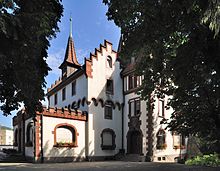
The Brombach district has its own directly elected by the citizens since 1976 Ortschaftsrat , the town councils of twelve honorary including a Ortsvorstehers is as chairman. The last election took place on May 26, 2019. The electoral term lasts five years. In the last election, the Free Voters won seven seats with 58.53%, the CDU with 17.99% two seats and the SPD with 23.48% three seats. The head of the village is Silke Herzog from the Free Voters.
The seat of the local administration has been the Brombacher Castle since January 10, 1967 . It was acquired by the Großmann family in 1962 and converted by a municipal resolution in 1965, and the palace gardens were made accessible to the public. The last mayor of the independent village of Brombach was Franz Leber from 1965 until Brombach's independence was given up. Since May 28, 1942, the office of mayor has been full-time. In the term of office from 1971 onwards, the mayor was assisted by a council of 16 members.
Bailiffs and Mayors
At the same time as the Margraves of Hachberg-Sausenberg, village bailiffs appeared in the villages that were under the influence of the Lords of Rötteln. The first Vogt in Brombach was the nobleman Rudolf von Berne. Until the beginning of the 19th century, the bailiffs served as civil servants on behalf of the margrave. The bailiffs acted as judges in the village court and members of the state committee. Their office was usually not remunerated, but in addition to a reputation it brought exemption from compulsory labor, taxes and civil duties. It was not until 1830, with the municipal law, that Brombach was no longer headed by a bailiff, but by a mayor . Until 1942 the mayor's office was honorary; only since May 28, 1942 did it become full-time.
The mayors of Brombach in the 20th century were:
- 1900–1913 Johann Marx
- 1913–1917 Ernst Friedrich Ehret
- 1919–1933 Franz Ehret
- 1933–1945 Josef Schmidberger
- 1945–1946 Franz Ehret
- 1947–1948 Ernst Jenne
- 1949–1958 Ernst Meier
- 1957–1965 Franz Ehret Jr.
- 1965–1974 Franz Leber
coat of arms
The Brombacher coat of arms is one of the so-called " talking coats of arms " and shows a red fountain with a blue beam over a blue wave bar. The background is silver (white). The colors of the coat of arms were determined by the General State Archives in 1902. The coat of arms goes back to an embossed seal from the first half of the 19th century, which still shows a running bowl fountain with two tubes. The motif, which dates back to 1830, comes from the incorrect interpretation of the place name Bronn as a fountain . The wave bar symbolizes the river Wiese.
Culture and sights
Buildings
The foundations of a Roman manor from the 2nd century AD are located on the " Bühl" mountain in the village . It was discovered in 1979 and excavated in 1981 and restored. The excavations revealed that the courtyard must have burned down. Some charred apples were found in the rubble, and can be seen today in the Dreiländermuseum in Lörrach.
The Sculptor Rudolf Scheurer Foundation is also located on the Bühl . Sculptures, reliefs and graphics by the artist Rudolf Scheurer from Hauingen are permanently on display in a twelve-meter-high tower, as well as in the surrounding garden and the access route.
The center of Brombach partly consists of half-timbered houses, some of which date from the 14th century.
The former moated castle was first mentioned in 1294, but was destroyed by French troops in 1678, as was Rötteln Castle . The four- winged Brombach Castle , rebuilt in 1880 and rebuilt in 1900 , initially served the Großmann factory owners as a residence and was sold to the Brombach community in 1962. Since 1966 it has served the local administration as the seat and conference venue. The registry office of the city of Lörrach is also located here. The castle is surrounded by a small park, which is used for a weekly market on Wednesdays. The neighboring coach house was renovated in 2002. The building is partly used as a residential building and partly as a branch of the Lörrach City Library.
The evangelical Germanus Church sits enthroned on a hill, visible from afar . The medieval tower dates from the 14th century, the originally late Gothic choir was added in the Wilhelmine style between 1903 and 1905 . The renovation increased the capacity of the church from 430 to 810 seats. The three windows in the choir show the apostles Paul, Peter, John and James. In the middle, Jesus is shown being baptized by John the Baptist. The church has three bells, the largest from 1595. A crucifix dates from 1479. A little above the church there is a memorial for the victims of both world wars. The memorial from 1923 was redesigned in 1959 by the sculptor Rudolf Scheurer. It contains a total of 232 names of dead and missing persons from the Second World War on 13 granite tablets.
The Catholic St. Joseph's Church is located on the thoroughfare next to the Brombacher Friedhof . It was built from 1899 to 1900 and is kept in simple Gothic forms. It was consecrated on November 25, 1900 by Auxiliary Bishop Justus Knecht . The church offers 450 seats and 300 standing places. The high altar was made by the Freiburg sculptor Joseph Dettlinger in 1906. In the adjacent cemetery there is a chapel with a bell tower from 1867.
societies
Brombach has its own football club, the FV Brombach 1911 eV The 600-member club provides several teams in the youth and men's area. The home stadium is in the Hugenmatt . In the 2009/10 season, the football club played in the national league . In 2011 the club merged with FV Lörrach and has since played under the name FV Lörrach-Brombach in the Association League South Baden.
The handball players of TV Brombach played in the 3rd league in the 2016/17 season .
In addition, there are over 30 clubs in the fields of sport, music, carnival and welfare.
Since May 2018, a new multi-purpose hall has been built on the old Schöpflin site not far from the S-Bahn station in Brombach, which is intended to replace the old sports hall from 1967. Considerations for the construction of a new sports hall go back to the beginning of the 1990s and were founded by a support association set up by TV Brombach. The two-part sports hall with a sports area of 45 × 30 meters is to include a mobile, extendable grandstand for 540 spectators. In addition to sports facilities, the hall should also allow events for up to 500 people. The completion of the new sports hall was planned for March 2020.
Events
Every year over 50 events take place in Brombach, which have become established over the past few years. This includes balls and parades of the local carnival clubs. The biggest festival in town is the Schlossgrabenfest , which takes place every year on a September weekend ; which is held along the Ringstrasse and the Castle Park.
Natural monuments
⊙ "Große Eiche" on Römerstrasse. Amonumentalpedunculate oakthat is at least 400 years old and is designatedas anatural monument(ND-Nr. 83360500002)in the city forest with a circumference of 7.95 m and a height of 28 meters (2015).
See also: List of prominent and old tree specimens
Infrastructure and economy
Educational institutions
Brombach has had a school since the 17th century at the latest and a teacher has been documented since 1604. Up until the 18th century , teachers worked part-time and, for example, worked as clerks on the side. Before 1660 a school house was built in Brombach; however, this did not survive the subsequent wars. Since teachers held lessons in their own apartments well into the 18th century, the village acquired a residential building in 1786, which was converted into a schoolhouse and served this purpose until it was rebuilt in 1840/43.
The Hellbergschule is located in Brombach today and is used as a primary, secondary and technical secondary school. The old school building dates from 1892. The club house in the old trade school from 1913 in Badstrasse is now used as a branch of the Lörrach adult education center.
traffic
Road traffic
The federal road 317 , which connects the Wiesental with Lörrach, runs north of the Brombach district . A thoroughfare that runs parallel to the main road runs through the town center itself.
Rail transport
The village is connected to Basel , Weil am Rhein , Steinen , Schopfheim and Zell im Wiesental via the S-Bahn lines S5 and S6 of the Basel S-Bahn and is a stop on the Wiesentalbahn , which was operated by Deutsche Bahn AG until 2003 . In 2002, as part of the changeover to S-Bahn operations, a new station with a raised platform was built to better meet the requirements (especially with regard to accessibility ).
The place shares the breakpoint at the Wiesentalbahn with the neighboring community of Hauingen . For timetable change 2009/2010 on 13 December 2009 he was therefore of Brombach (b Lörrach) in Loerrach-Brombach / Hauingen renamed.
In 2010, an electronic train indicator was installed at the Brombach / Hauingen stop - just like at all other Wiesentalbahn stations .
The former Brombach station had particularly high ticket sales in 1924. A total of 136,036 tickets were sold.
Bus transport
The bus lines 6 and 16 of the Regio Verkehrsverbund Lörrach connect Brombach with the other city and districts of Lörrach as well as with Weil am Rhein and Riehen .
fire Department
Brombach's fire brigade was founded in 1872 as a voluntary fire brigade and incorporated into the Lörrach fire brigade in 1974 . There are 44 active firefighters, twelve youth firefighters and 18 members of the senior team. In addition to fire operations for the location, she is also responsible for traffic accidents in connection with the districts of Haagen and Hauingen.
Power line
In the southern part of Brombach through the settlement area on the Bühl, two high-voltage and one extra-high voltage lines run. The high-voltage lines are two 110 kV lines that run north from the Rheinfelden power transmission plants . The extra high voltage line is a 380 kV line. It leads from the Kühmoos substation to Daxlanden in northern Baden .
economy
The traditional flour factory Reiss-Mühle was located in the center of Brombach . The origins of the company go back to the miller and baker Johann Reiss. He bought an old mill in 1782, which is documented in 1573. In the mill, which was completely rebuilt in 1902 and extensively modernized in 2014, up to 150 tons were ground every day. After 237 years of operation, the company closed in April 2019.
At the turn of the century, Lauffenmühle an der Wiese was one of the largest employers in Brombach with around 400 workers. The textile finishing company was founded in 1899 by Adolf Feer (1862–1913) from Switzerland under the name Appretur & Druckerei Brombach GmbH and was taken over in 1963 by Lauffenmühle in Lauchringen . After the company's fifth bankruptcy at the beginning of 2019 , all operations were closed on July 31, 2019 . In Brombach this still affected 76 employees.
The central European distribution warehouse of the international fashion company Tally Weijl has been located in Brombach since 1999, on the site of the former logistics center of the former Schöpflin mail order company. The headquarters of the textile mail order company Mode & Preis is also located in the former premises of Schöpflin .
The Swiss cement producer Holcim Kies und Beton GmbH has a production site in Brombach. For this purpose, he maintains a cement works with a 26-meter-high vertical system at the southern entrance to the town, not far from the Wiesentalbrücke , part of the A 98 . The facility was opened in the early 1980s specifically for the construction of the motorway bridge.
The Wenk-Walzen company is also based in Lörrach through the textile industry . The company was founded by Karl Wenk in 1919 and has been in the family for four generations.
Personalities
Sons and daughters
- Emil Frey (1898–1995), Swiss entrepreneur
- Rudi Krawitz (* 1943), university professor for education
- Erich Marx (* 1921), entrepreneur, art collector and patron
- Hans Schmidberger (* 1925), architect and retired professor
- Volkmar Staub (* 1952), cabaret artist
- Gabi Roth (born Lippe, * 1967), track and field athlete and Olympic participant
Other personalities
The German internist Wilhelm His spent the last years of his life in Brombach, died there in 1934 and was buried in his native Basel.
The former successful marksman Karl Wenk is based in Brombach . Wenk won many national and international titles, including four-time European and two-time world champion as well as a participant in three Olympic Games . Wenk continued to run his father's roller engraving factory Karl Wenk GmbH . He also worked as a hunter who leased an area of 900 hectares of forest in Brombach.
Movies
- A love in Germany , drama, Germany, 1983, 132 min., Director: Andrzej Wajda
literature
- Brombach community (ed.), Fritz Schülin : Brombach , 789–1972, contributions to local, landscape and settlement history.
- Gerhard Moehring : A short history of the city of Loerrach . DRW-Verlag Weinbrenner, Leinfelden-Echterdingen 2006, ISBN 3-7650-8347-X
- Johannes Mulsow: Brombach im Wiesental , A contribution to local history, Lahr 1905.
- Landesarchivdirektion Baden-Württemberg, Landkreis Lörrach (ed.): Der Landkreis Lörrach , Volume II (Kandern to Zell im Wiesental), Jan Thorbecke Verlag Sigmaringen 1994, ISBN 3-7995-1354-X , pages 95/96, 129-136
- Franz Xaver Kraus : The art monuments of the Grand Duchy of Baden , Tübingen and Leipzig, 1901, fifth volume - Lörrach district; Pp. 5-7 online
Web links
- Historical representation of Brombach
- Chronological listing of historical dates
- Regional information system for Baden-Württemberg (LeoBW): Brombach - archive material
- German digital library : Digitized objects on Brombach
Individual evidence
- ↑ Ernst Beck, phonology of the Obermarkgräfler dialect , Halle (Saale): Buchhandlung des Waisenhauses, 1926, p. 74 (§ 113.1) and p. 108 (§ 261, 2)
- ^ Federal Office for Topography Switzerland: Coordinating body for federal geographic information. Retrieved March 2, 2020 .
- ↑ Schülin: Brombach , page 45
- ↑ St. Gallen Document Book I 90
- ↑ Schülin: Brombach , page 913
- ↑ Schülin: Brombach , page 51
- ↑ Schülin: Brombach , page 1128
- ↑ Schülin: Brombach , page 631
- ↑ a b Brombach's coat of arms and village name
- ↑ For the certificate, see Joseph Trouillat: Monuments de l'histoire de l'ancien évêché de Bâle, Volume 2 , Porrentruy, 1854, pp. 566f. Available online on Google books
- ↑ Schülin: Brombach , page 68
- ↑ Old Basel: Mayor Konrad von Bärenfels
- ↑ Marcel Clémence: von Bärenfels. In: Historical Lexicon of Switzerland . January 15, 2002 , accessed June 25, 2019 .
- ↑ Schülin: Brombach , page 479
- ↑ Thomas Simon: manorial rule and bailiwick. A structural analysis of late medieval and early modern rule formation , Frankfurt, 1995, p. 414; For ownership see also Roller, Otto: The history of the noble lords of Rötteln , in Blätter aus der Margrafschaft, Schopfheim, 1927, p. 25
- ↑ Regesten the Margrave of Baden and Hachberg 1050-1515, published by the Baden Historical Commission, edited by Richard Fester , Innsbruck 1892, Volume 1, certificate number H603 online
- ↑ Regesten the Margrave of Baden and Hachberg 1050-1515, published by the Baden Historical Commission, edited by Richard Fester , Innsbruck 1892, Volume 1, certificate number H624 online
- ↑ Schülin: Brombach , page 933
- ↑ The district of Lörrach , Volume II, page 130/31
- ^ Moehring: Brief history of the city of Lörrach , page 100
- ^ Federal Statistical Office (ed.): Historical municipality directory for the Federal Republic of Germany. Name, border and key number changes in municipalities, counties and administrative districts from May 27, 1970 to December 31, 1982 . W. Kohlhammer, Stuttgart / Mainz 1983, ISBN 3-17-003263-1 , p. 521 .
- ↑ Schülin: Brombach , page 577
- ↑ Schülin: Brombach , page 581
- ↑ a b c Schülin: Brombach , page 578
- ^ The district of Lörrach , Volume II, page 103
- ↑ (May 17, 1939) Schülin: Brombach , page 416
- ↑ (January 1, 1949) Schülin: Brombach , page 416
- ↑ (December 31, 1950) Schülin: Brombach , page 416
- ↑ a b Schülin: Brombach , page 545
- ↑ December 31, 2006
- ↑ Schülin: Brombach , pp. 971–974
- ↑ Schülin: Brombach , page 912/13
- ↑ Religious affiliation 1858 and 1925: Brombach , last accessed on May 24, 2019
- ^ Religious affiliation : Brombach , last accessed on May 24, 2019
- ↑ Badische Zeitung (June 10, 2009), local council Brombach
- ↑ Elections for Brombach's local council in 2019 , last accessed on May 29, 2019
- ↑ Schülin: Brombach , page 480
- ↑ Schülin: Brombach , pages 584-588
- ↑ Schülin: Brombach , pages 478/79
- ↑ Schülin: Brombach , pages 480
- ↑ The second term of office took place through the establishment of the occupation authority
- ↑ Huber: Wappenbuch Landkreis Lörrach , ISBN 3-87799-046-0 , page 72.
- ^ Moehring: Brief history of the city of Lörrach , page 134
- ↑ Schülin: Brombach , page 233
- ↑ Data on FV Brombach eV ( Memento of the original from April 14, 2009 in the Internet Archive ) Info: The archive link was automatically inserted and not yet checked. Please check the original and archive link according to the instructions and then remove this notice.
- ^ TV Brombach: Förderverein Sporthalle , accessed on July 22, 2019
- ↑ Press release of the city of Lörrach: Sports hall Brombach , accessed on July 22, 2019
- ↑ Monumental oaks
- ↑ The district of Lörrach , Volume II, page 134
- ↑ Press release of the city of Lörrach (December 17, 2009): Lörrach station becomes the main station - new station names in the city of Lörrach
- ^ Badische Zeitung (Lörrach edition, December 16, 2009): Lörrach now has a main train station
- ^ Johann Hansing: The railways in Baden. A contribution to traffic and economic history . Fleischhauer & Spohn, Stuttgart 1929, p. 63.
- ↑ Lörrach volunteer fire brigade, Brombach department ( Memento of the original from August 28, 2011 in the Internet Archive ) Info: The archive link was inserted automatically and has not yet been checked. Please check the original and archive link according to the instructions and then remove this notice.
- ^ Jaumann publishing house : Reiss-Mühle stops production. , Article from March 28, 2019, last accessed on May 14, 2019
- ↑ Company profile of Reiss-Mühle , last accessed on May 14, 2019
- ^ Moehring: Brief history of the city of Lörrach , page 97
- ↑ https://www.verlagshaus-jaumann.de/inhalt.loerrach-lauffenmuehle-stadt-kauf.f0df7507-c79c-45bf-950f-fe01c450bfa8.html Guido Neidinger: Lauffenmühle: City buys , in: Die Oberbadische , July 16 2019.
- ↑ Wenk rollers - portrait. Retrieved July 20, 2019 .


